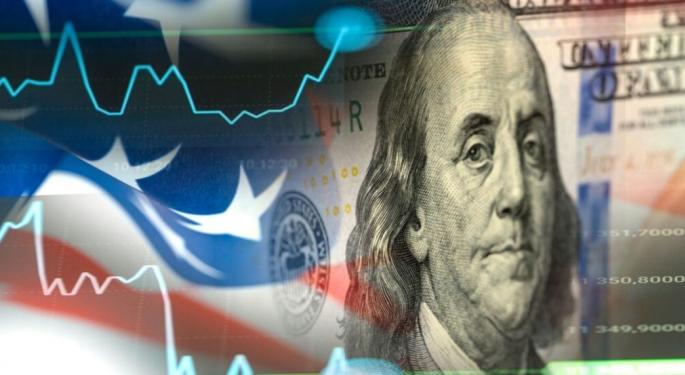Dollar Dumps In November As Fed Rate Cut Optimism Increases
The U.S. dollar made something of a comeback in the last two days of November, following a month of losses as markets leveraged rising expectations the Federal Reserve will start cutting rates in the first quarter of 2024.
Although the dollar index (DXY) was fractionally lower on Friday, during the final two days of November the DXY gained a cumulative 0.6%.
But analysts believed the rally would be short-lived while equities continued to surge and rate cut optimism remained high. Bank of America FX strategist Athanasios Vamvakidis said: “We are bearish on the dollar into 2024 — we could see a correction from oversold positions into the year end, but would sell the bounce for a 2024 decline.”
Also Read: Dollar Decline: Stock Market Rally Explains 70% Of Recent US Dollar Downtrend
Dollar Decoupling
In November, as investors’ appetite for risk led to major gains in the equity markets, the dollar largely diverged from its usual drivers tied to the economy, geopolitics, and policy. Instead, it became the anti-equity trade.
As the S&P 500 stock index climbed 8.9% during November, the dollar index (DXY) fell 3.1%. During the same period, the SPDR S&P 500 ETF (NYSE:SPY), an exchange-traded fund that tracks the S&P 500, gained 9.1%.
Among the major currency crosses, the dollar’s worst performance during November was against the New Zealand dollar (NZD/USD) — down 4.6%. The dollar lost 3.6% versus the British pound (GBP/USD) and was down 2.6% against the euro (EUR/USD).
The performance of exchange traded funds tracking investment behavior in the dollar also illustrated market sentiment towards the U.S. currency. The Invesco DB USD Index Bullish Fund ETF (NYSE:UUP) fell 2.5% during November, while the Invesco DB US Dollar Index Bearish Fund (NYSE:UDN) rose 3.3%.
Treasury Market Rally — Yields Retreat From 5%
The biggest market driver during the month was rising expectations that the Federal Reserve had ended its cycle of interest rate hikes, after the central bank left its main Fed Funds Rate at 5.25%-5.5% at its September and November policy meetings.
Expectations of a more dovish Fed at the Dec. 13 meeting were further driven by data that showed inflation becoming more benign. Consumer price data in early November showed the annual headline inflation rate dropping to 3.2%, while the rate as measured by personal consumption expenditures — the Fed’s favored measure — fell to 3%. The Fed’s target rate is 2%.
Hopes of a more dovish Fed also spurred a rally in the U.S. government bonds market. Prices climbed, driving yields lower from 16-year highs. Having peaked at 5.02% in October, the 10-year Treasury yield was down to 4.32% on Friday.
The iShares Core U.S. Aggregate Bond ETF (NYSE:AGG), an exchange traded fund that tracks the broad U.S. bond market, gained 4.3% during November.
Now Read: November Rally Sets Treasury Bonds On Track For Best Month In 40 Years
Photo: Shutterstock
This article was submitted by an external contributor and may not represent the views and opinions of Benzinga.
© 2025 Benzinga.com. Benzinga does not provide investment advice. All rights reserved.
Posted-In: News Bonds Currency ETFs Forex Economics Federal Reserve Markets ETFs



